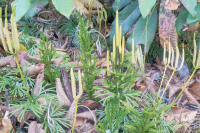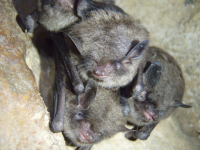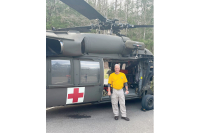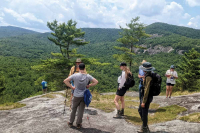Panthertown chosen for Leave No Trace awareness program
Panthertown Valley’s popularity is increasing, and advocates for the backcountry area — located near Cashiers in the Nantahala National Forest — hope its newfound designation as a Leave No Trace Hot Spot will help head off some of the less-than-pleasant effects of that popularity.
Panthertown purchase gets a boost
A key piece of land bordering Panthertown Valley Backcountry Area will be conserved following a pledge from the Jackson County Commissioners to cover any gap between fundraising dollars and land price that still exists by the April 21 closing date.
Jackson considers giving toward land conservation effort
The fundraising deadline is drawing nearer for an effort to conserve 15.9 acres adjacent to Panthertown Valley, and the Jackson County Commissioners have indicated a willingness to chip in toward the more than $80,000 still needed.
Forest service ignites firestorm over proposed burn
 The U.S. Forest Service is proposing a controlled burn in Panthertown Valley, a popular recreation area in Jackson County dissected with hiking and biking trails, abundant waterfalls and camping sites.
The U.S. Forest Service is proposing a controlled burn in Panthertown Valley, a popular recreation area in Jackson County dissected with hiking and biking trails, abundant waterfalls and camping sites.
The allure of Panthertown Valley is timeless
The announcement in November 1989 that the remote 6,300-acre Panthertown Valley tract in Jackson County had passed into the public domain was welcome news for knowledgeable outdoor enthusiasts throughout the southeastern United States. After years of private management, this truly unique region encompassing the headwaters of the Tuckaseigee River was opened for use by the general public. Those with a penchant for exploring backcountry areas have found that Panthertown is their ticket to paradise.
After being sparsely settled in the 19th century, the extensive tract passed into private hands about the turn of the century. After World War I, property rights were acquired by a lumber company that initiated operations in the 1920s. A rail spur connecting the valley with the Southern Railway system was run from three timber camps operating along the watershed. Logging operations ceased by the late 1930s, but traces of the old rail line can still be located, especially where it crossed over rock outcrops in Panthertown Creek in the uppermost portion of the watershed. In the early 1960s, the tract was purchased by a land investment corporation associated with a South Carolina-based insurance company. Through the years a few tracts on the edge of Panthertown were sold and various development possibilities considered — including a lake that would have inundated Panthertown Valley — but little development actually occurred other than minimal road improvements and ornamental tree plantings.
In January 1988, Duke Power Co. purchased the tract from the insurance company for a 230-kilovolt transmission line it wanted to run from a generating facility at Jocassee, S.C., to its proposed subsidiary, Nantahala Power and Light Company, for connection at a substation located in the Tuckaseigee River watershed. After extensive hearings on the local and state levels, Duke Power was cleared for the Nantahala Power purchase and the right to run the transmission line across the valley. The company required but 800 or so acres for the line right-of-way and sold the remainder of the tract for $7,875,000 to the North Carolina Nature Conservancy, which in turn promptly signed the deed over to the U.S. Forest Service for approximately that amount. Panthertown Valley is curently administered by the Highlands Ranger District of the Nantahala National Forest. Commercial timber production is unlikely as the tract is being managed under a Forest Service 4-C classification.
The most direct and scenic route to Panthertown Valley is to turn east at the crossroads in Cashiers onto U.S. 64 and proceed 1.8 miles before turning left onto Cedar Creek Road. At 2.1 miles, turn right onto Breedlove Road and proceed 3.3 miles to the gated trailhead. Study the map posted at the trailhead. Also consult the “Big Ridge” and “Lake Toxaway” U.S. Geological Survey quadrants, available at numerous outfitters in the Highlands/Cashiers area.
An excellent description of Panthertown Valley is provided by James H. Horton in a chapter titled “Physical and Natural Aspects” contributed to “The History of Jackson County” (1987). An article titled “Saving Panthertown Valley” by Vic Venters appeared in the May 1991 issue of “Wildlife in North Carolina.”
A short walk down the roadway and around the first bend leads to Salt Rock, one of the most delightful views in the southern highlands. From this overlook on the southwest rim of the Panthertown watershed a series of extensive rock outcrops that rise from 200 to 300 feet above the valley can be observed. (As power lines go, the one that Duke Power ran across the valley is not particularly obtrusive; you have to know just where to look to spot it, and even then the darkened steel towers blend in with the landscape as they are not silhouetted against the sky.) The broad valley floor and almost vertical rock-face terrain has led some to describe the area as “The Yosemite of the East.”
Western Carolina University biologist Dan Pittillo makes the point that Panthertown Valley resembles what the Yosemite Valley of California “might look like following several million years of erosion.” It’s a region of flat meandering tannin-darkened streams often bordered by white sand banks, extensive waterfall systems that form grottoes in which rare tropical ferns reside, large pools several hundred feet in length, high country bogs and seeps that harbor vegetation not often encountered elsewhere in the mountains, upland “hanging” valleys on the sides of the tract, and rocky outcrops where ravens nest.
Schoolhouse Falls on Greenland Creek is one of the most beautiful settings of its type in the southern mountains. Botanists who have surveyed Panthertown think that it contains “perhaps the largest collection of mountain bogs found south of West Virginia,” and the tract contains “at least 14 species of globally endangered plants.” Approximately three-quarters of a mile below Salt Rock overlook, you’ll come to a point where the road branches in three directions. The middle fork takes you down the left side of Panthertown Creek (the main headwater stream of the Tuckaseigee River) to a large pool, a bridge crossing, and access to Schoolhouse Falls. The right fork will lead you past a primitive camping site to a bridge. Turn right after crossing this bridge along a trail that will quickly bring you to a waterfall and pool area that’s a superb place for relaxing.
Editor’s note: This Back Then article first appeared in The Smoky Mountain News in May 2001.
George Ellison can be reached at P.O. Box 1262, Bryson City, N.C., 28713, or at This email address is being protected from spambots. You need JavaScript enabled to view it..
New Friends of Panthertown president brings wealth of skills
Margaret Fry Carton of the Cashiers area has been elected president of the Friends of Panthertown, a nonprofit that protects, preserves and promotes Panthertown Valley, a national forest enclave of unusual beauty and stunning natural features near Cashiers.
"We will continue our work to ensure that Panthertown remains a vibrant and protected natural resource for our community, and for the unique flora and fauna the flourishes here," Carton said. "This organization represents a unique partnership between conservation minded individuals and the Forest Service."
Carton, who lives in the Cashiers, retired in 2005 from Coca-Cola Enterprises as the vice president, chief information officer. Before that, she was the vice president of investor relations and planning and managed several financial functions, including investor and share-owner relations, employee communications, financial media relations, and strategic financial planning and analysis. Her husband is an associate professor and department head for entrepreneurship, sales and marketing, and hospitality and tourism at Western Carolina University.
Panthertown is located in the Nantahala National Forest between the mountain communities of Cashiers in Jackson County and Lake Toxaway in Transylvania County. Carton is also the chairman of the Rabun Gap-Nacoochee School Board of Trustees in northeast Georgia. In addition, she serves on the board of the Atlanta Ballet and is a member of the Western Carolina University Computer Information Systems Advisory Board.
Carton is the second president of Friends of Panthertown, succeeding David M. Bates, the organization's first president and co-founder, who passed away last year.
Panthertown to hold workday
The Friends of Panthertown will hold its monthly Trail Work Day on Oct. 23.
Volunteers should meet at the Salt Rock parking area at 9:30 a.m. Tools will be provided and no experience is necessary.
The trail group will hike less than 5 miles and will be finished before 3 p.m. Visit the volunteer homepage at www.panthertown.wordpress.com/volunteer/ for more information on what to bring, how to prepare and what to expect. You can also sign up to receive an e-newsletter and get on the Friends of Panthertown mailing list by updating your e-mail subscription in the menu box on the right side column of the website.
Putting Panthertown on the map
Every hiker has likely named a trailside feature or two in their day. Ferns sprouting from the banks of a waterfall give rise to Fern Falls, or a flat granite outcrop stumbled upon mid-day becomes the ever-descriptive Lunch Rock.
For most of us, the names fade into oblivion, but for a lucky few, the names they come up with are committed to paper and adopted by hikers everywhere — especially if you’re the guy making the map.
“When you map a place you get to name things,” said Burt Kornegay, owner of Slickrock Expeditions.
Such was the case for Panthertown, the bowl-like valley flanked by granite domes, known as Yosemite of the East. It perches on the Cashiers plateau, its waterfall-laden streams feeding the headwaters of the Tuckasegee River. It was once considered a “best-kept secret,” with a maze of unmarked trails, unnamed waterfalls and uncluttered campsites.
It’s safe to say Panthertown has been discovered, witnessed by the 15,000 maps Kornegay has sold of Panthertown in the past decade. His map was the first and only one depicting the trails, and as a result, he got to name stuff, lots of stuff — like the previously unnamed Jawbone Falls.
“The first time I ever walked out on it there was a beaver jaw laying on the rock. So that’s how I started referring to it,” Kornegay said.
He can also take credit for Halfway Falls, which, incidentally, is halfway between Greenland Falls and Carlton Falls.
Kornegay used intuitive names when possible. A waterfall that empties into a giant pothole in the rock below was plainly named Pothole Falls. Names bestowed on trails usually pay homage to natural features along their route, like the West Fork Way trail, which follows the West Fork of the French Broad River in the Big Pisgah portion of Panthertown.
Kornegay also named the massive granite wall known as the “Great Wall of Panthertown” and the trail known as the Great Wall Trail.
When Kornegay first began naming things in Panthertown, his motive wasn’t map-making. It was simply to communicate with the handful of other hikers who, like Kornegay, enjoyed Panthertown as their own personal backyard playground.
“When you tell someone ‘I’ll see you at such and such falls,’ you better be talking about the same place,” Kornegay said.
Of course, some people had adopted their own names for the same place. Kornegay can think of half a dozen names people still use to refer to one waterfall — a product of the hiker’s paradise lacking an official map for so long.
Kornegay’s first maps of Panthertown were mere line drawings, sketched in on a standard issue USGS topo map to help him remember where he’d been and where he had yet to explore.
The area known as Panthertown was largely a big blank spot.
As luck would have it, Panthertown didn’t fall neatly within one USGS quadrant. He had to piece together the corners of four maps to replicate Panthertown.
Kornegay could have kicked back at his kitchen table with a cup of tea and drawn all the trails from memory.
“I had been hiking them for years by then,” Kornegay said.
But for good measure, Kornegay hiked the trails and drew them in as he went.
He ran off 100 copies on a color copier, mostly to share with clients on his guided outfitter trips. But word soon got out in the hiking community that someone had made a map of Panthertown trails, and they’ve sold like hotcakes ever since.
For the first time in 12 years, Kornegay has updated the map and released a new and improved version. There’s only one downside, for him anyway. It’s made out of tear-proof, waterproof paper.
“These ones won’t wear out. It’s going to hurt sales,” Kornegay said.
While Kornegay’s map was the only one out there for years, the forest service has recently come out with a map of its own. Kornegay’s map is more detailed, however, showing several trails and waterfalls that don’t appear on the forest service one.
When making a map, the forest service didn’t have the knowledge base of Kornegay and his Panthertown comrades. They were unfamiliar with colloquial names assigned to various knobs, trails, creeks and the like.
So a map naming session was convened with several Panthertown experts to hash out official names for the forest service map.
The meeting of the minds managed to label the final handful of features that still lacked a name — including the final unnamed waterfall of Panthertown’s wilds.
“Someone said ‘That’s near Mac’s Gap, Let’s call it Mac’s Falls,’” Kornegay said.
Want to hike Panthertown?
Trail maps of Panthertown Valley can be purchased for $12 at Blackrock Outdoors and City Lights in Sylva or Highland Hiker in Highlands. Or go to www.slickrockexpeditions.com.
Dubbed the “Guide’s Guide to Panthertown, Bonas Defeat and Big Pisgah,” the name is a throwback to the map’s author Burt Kornegay, an outdoor guide who frequently leads trips in Panthertown.
To reach Panthertown, you have to take side roads off N.C. 107 or N.C. 281 in southern Jackson County. Directions to the parking areas are found in the map. The back of the map has a detailed explanation of Panthertown’s natural and human history, along with suggestions for possible hikes.
Panthertown trail plan designates use
A new trail management plan designed to rein in heavy use by competing forms of recreation in Panthertown Valley will be discussed at a public meeting from 5 to 7 p.m. on Wednesday, Sept. 9, at the Cashiers Library.
The Friends of Panthertown organized the meeting to inform the public about changes coming to the trails in Panthertown Valley.
The forest service recently finalized a trail management plan that will designate certain trails as hiker only, making them off-limits to horseback riders and mountain bikes.
Panthertown is a 6,000-acre tract near Cashiers with unique features, including a bowl-shaped valley, granite domes and waterfalls. It has historically been a free-for-all, with all uses allowed on all trails. But a rise in popularity was causing conflict between users as well as damage to more fragile trails, according to the forest service.
Restrictions will “maintain the recreational experience provided by Panthertown” and “prevent resource degradation,” Forest Supervisor Mike Wilkins wrote in his justification of the final trail plan.
About half the trails in Panthertown will now be for hikers only. In addition, commercial horse trips and guided mountain bike trips will no longer be allowed anywhere in Panthertown.
The new trail management plan has been several years in the making. As part of the plan, parking will be improved at three access areas and trail signage will be installed noting the names of trails and distances. Some users created trails through fragile areas will be decommissioned. Camping will continue to be allowed anywhere, except within 50 feet of a creek.
Friends of Panthertown has arranged for a representative from the forest service to attend the meeting to answer questions about the new recreation management plan.
“We encourage you to attend the meeting to learn how you can support Friends of Panthertown and become a part of what’s going on in Panthertown Valley,” said Nina Elliott, the Friends of Panthertown coordinator.
Friends of Panthertown has worked closely with the forest service during the process to provide feedback and represent stakeholders. The group organizes monthly trail workdays and other volunteer projects, logging more than 1,500 hours maintaining trails, building bulletin boards at trailheads, and collaborating with the forest service on a new trail map last year.
Friends of Panthertown will coordinate volunteer labor to help implement elements on the new trail plan, including trail rehab and installing trail markers and signage. Work days are on the fourth Saturday of the month.
For more info, go to www.j-mca.org or call 828.526.9938, ext. 258, or email This email address is being protected from spambots. You need JavaScript enabled to view it..
Long-awaited Panthertown maps, trail signs move forward
The Friends of Panthertown has received a $7,500 grant from the Blue Ridge National Heritage Area to develop a trail guide and interpretive signs for Panthertown Valley.
Panthertown, a bowl-shaped recreation area outside Cashiers marked by granite domes and waterfalls, has garnered accolades as a unique landscape unparalleled in Western North Carolina.
Each year, numerous visitors get lost trying to navigate the network of trails and old logging roads that traverse the 6,300 acres, reports Nina Elliott, the Friends of Panthertown Coordinator.
“We’ve received repeated requests to map and mark trails in Panthertown Valley,” Elliott said. “Mapping and marking trails will direct visitors to favorite destinations without getting lost, and if someone should get injured, EMS will be able to locate and evacuate victims quickly.”
A few purists lament the taming of trails in Panthertown, preferring the lack of signage that gives the tract the feel of backcountry and requires a know-how with a topo and compass. But the hodgepodge of trails and the lack of maps and signage prevent people who would like to hike in the area from doing so.
“Trails do more than just guide people along a path. With the help of devoted groups of people like the Friends of Panthertown, trails protect and preserve the world’s most beautiful and irreplaceable areas,” says Elliott. “Above all, projects like this educate people on the importance of the land, the wildlife, and the natural resources that are so vital to our ecosystem, protecting sensitive ecological areas for future generations.”
The Friends of Panthertown, sponsored by the Jackson-Macon Conservation Alliance, are currently working with the U.S. Forest Service to create a map of the of the trail system, develop a sign plan, and install bulletin boards and interpretive signs at trailheads.
But there’s one catch: an additional $11,500 is needed to complete the Panthertown Trail Project and provide matching funds for the grant. Please help by contacting www.j-mca.org or 828.526.9938 or This email address is being protected from spambots. You need JavaScript enabled to view it..









